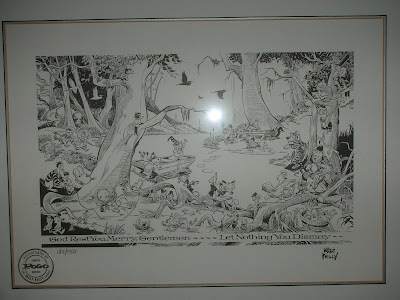Where was I? Right: at one of the market's dingy stalls, I saw a slim book that came with a sheet of fairly cool Spider-Man stickers. I like to put stickers on the occasional outbound piece of comics-related mail,* so I decided to pick these up:

You never know when you'll need a sticker of a camera or a thundercloud or a pair of balloons.
But part of the fun in this stickerbook is how egregiously off-model the characters are, in terms of their concerns and their abilities. The story makes no sense, even if you know nothing about Spider-Man and Dr. Octopus, but I have to assume that most of the book's target audience would know more than nothing. Here's what you get around your stickers:
Spider-Man is in New York, and a pleasant sunny day turns cloudy and stormy, so he figures something bad is happening. A garbage can flies by him while he's swinging toward the storm. Then he sees the storm is being caused by his old nemesis, Doctor Octopus:

Yep. Doc Ock is making lightning.

Many cephalopods are known for their weather-manipulation abilities. (Cuttlefish, for instance, can cause sleet.) So it's not surprising that the writer (uncredited) would make this mistake about good old Doctor Octopus. But in fact he's just a guy with extra mechanical tentacles. (Okay, I see the irony of using the phrase "in fact" to talk about Dr. Octopus. Sorry.) He doesn't have any mollusk powers at all! Why, he can't even change the color of his skin, or shoot out a cloud of ink!
I don't know why the writers didn't use Electro instead. He can't make storms, but he can at least make lightning; it's not a stretch. I've seen him on stickers here in the U.S. But maybe they figured Dr. Octopus was more recognizable, and they couldn't think of any way for him to be a menace other than making it rain on Manhattan.
Once he sees Spider-Man, he's in a hurry to get away, I guess, or to taunt Spidey from a safe disance:

Oh, yeah: did I mention that this guy could fly now?

Because, as everyone with a pool noodle knows, whirling a few flexible cylindrical tubes in the air is going to give you plenty of lift. Fortunately, Spider-Man realizes that there are only a couple of pages left in the book, so he snags his enemy on some webbing:

(I really like that look on Doc Ock's face, actually.) And that's the end. Never mind that none of those four mechanical arms are restrained in any way. Octavius's dignity is broken, and he surrenders meekly. The police come and take him away, for the heinous crime of weather manipulation, I guess. Or maybe there was a warrant out for a previous spree of cloud-seeding.
This reminds me all too much of the ending of another sitckerbook, Stick with Hulk, that I've been meaning to write about. The story's not important, although it's equally dumb. Here's the penultimate page:

Hulk wraps the Abomination in a chain-link fence and offers him a massage. Then, the stunning conclusion:

Hulk changes back to a fully-dressed Bruce Banner and effortlessly retrieves the radioactive macguffin from the snarling, super-strong Abomination, who is still struggling to free himself from his chain-link fence. It's for pleasures like this that I often linger in the toy aisle at the drugstore, or in shabby markets in little Welsh seaside burgs.
* This is the sort of postal goofery around that I'm talking about. See Spidey hop!





























